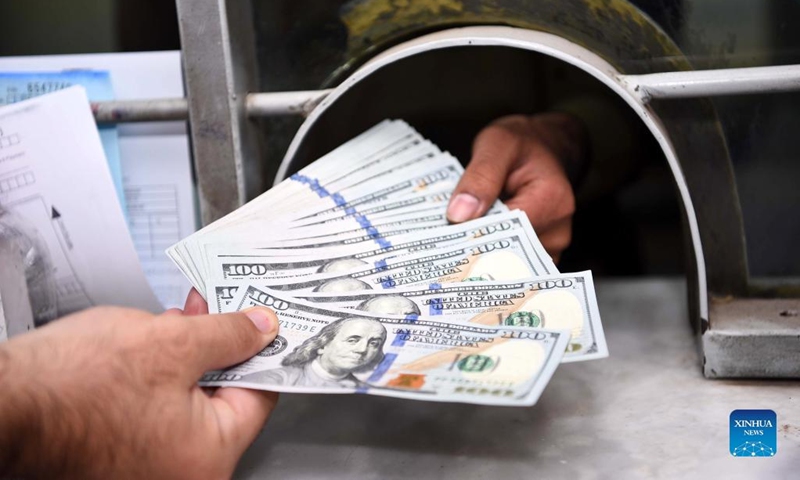China's holdings of US Treasuries fall to 12-year low amid diversification push to tackle risks
Trend reflects long-term diversification push amid rising risks: analysts

A currency changer gives U.S. dollar notes to a customer in Rawalpindi, Pakistan, on July 29, 2022. Pakistani rupee rebounded in the last trading session of the week on Friday, recording minor gains against the U.S. dollar after extending losses for 10 consecutive sessions in the interbank market, according to the State Bank of Pakistan (SBP).(Photo: Xinhua)
The Chinese mainland's holdings of US Treasury debt hit a fresh 12-year low in June, latest US official data showed, renewing contentions over what's behind the downtrend amid escalating tensions between the world's two biggest economies and an ailing US economy.
The shrinking stash indicates the country's continued efforts to restructure its foreign exchange reserves away from US government debt, argued some experts, while others interpreted it as an instance of swings in outstanding holdings factoring in a slide in US bond prices in the context of an interest rate hiking cycle.
The Chinese mainland held $967.8 billion of US Treasury bonds as of June, down further from $980.8 billion at the end of May, according to statistics from the US Department of the Treasury.
The mainland's holdings of US government debt fell below the $1 trillion mark in May for the first time since June 2010.
The continued downtrend mostly signals the country's reallocation of its forex portfolios, putting itself in a better position for risk hedging, Tan Yaling, head of the China Forex Investment Research Institute, told the Global Times on Tuesday.
Instead of fixating on US government debt holdings, the country has moved to diversify its forex reserves toward assets denominated in other currencies, Tan said.
The IMF recognizes eight major reserve currencies - the US dollar along with the yuan, the euro, the yen and the British pound - meaning that other portfolio choices are possible, the expert continued.
The reduced holdings of US government debt will "make room for the country to increase holdings of other assets," she reckoned, citing government debt denominated in other major currencies as among the choices for the diversification push.
The reallocation is envisioned to allow the country greater leeway in hedging against risks due to rising tensions between the world's top two economies, market watchers said.
Another recent example of the country's self-securing efforts, according to Tan, was separate announcements, all on Friday, by five Chinese state-owned firms saying they would delist from US exchanges.
In alternative explanations, the June data points to mostly non-transactional reasons.
The downtrend in cumulative holdings is largely attributed to a write-down in US bond prices, Tian Yun, former vice director of the Beijing Economic Operation Association, told the Global Times on Tuesday.
Bond prices are inversely related to bond yields, which have soared amid the Fed's drastic rate-hiking decisions.
As the US Federal Reserve's policy rate tops out next year, the current downward spiral in outstanding holdings may be reversed, observers estimated.
In a bylined article published by the Securities Times in late July, Guan Tao, chief global economist at BOC International (China) Co and a former senior official at the State Administration of Foreign Exchange (SAFE), accounted for the write-down.
A reduction in foreign holders' stock of US debt this year is an outcome of soaring US bond yields and falling bond prices, among other non-transactional factors, Guan wrote.
Monthly net changes actually paint a somewhat different picture.
The mainland's net purchase of US long-term securities totaled $3.17 billion in June, with $248 million of net sales in Treasury bonds, $4.09 billion in net purchase of agency bonds, $101 million in net corporate bond purchase, and $778 million in net sales of corporate stocks, according to a breakdown of the US Treasury data.
This mirrors the overall trend. "The sum total in June of all net foreign acquisitions of long-term securities, short-term US securities, and banking flows was a net Treasury International Capital inflow of $22.1 billion. Of this, net foreign private inflows were $23.1 billion, and net foreign official outflows were $1.1 billion," read a US Treasury statement on Monday.
The monthly dataset of net fluctuations revealed that the mainland's net purchase of US Treasury bonds hit $8.46 billion in April, before continuing net Treasury sales in May and June.
As the downtrend as measured by outstanding holdings is aligned with the continuation of rate hikes, it might reverse course as the Fed reaches peak, Tian forecast, expecting the current cycle of rate increases to run its course by the second quarter of next year.
As Guan put it, changes in Chinese investors' holdings of US debt shouldn't be over-interpreted. The country's push for diversification of its forex reserve assets kicked off long ago, Guan wrote, citing SAFE data.
China's US dollar-denominated reserve assets as a percentage of the nation's total had fallen to 59 percent by end-2016 from 79 percent at end-1995.
By the end of June, the country's forex reserves hit $3.07 trillion, down $178.9 billion from the end of last year, per official data.
The decrease, in line with the country's falling stock of Treasury bonds, is indicative of asset price revaluations amid rising bond yields versus a decline in bond prices, Guan noted.



